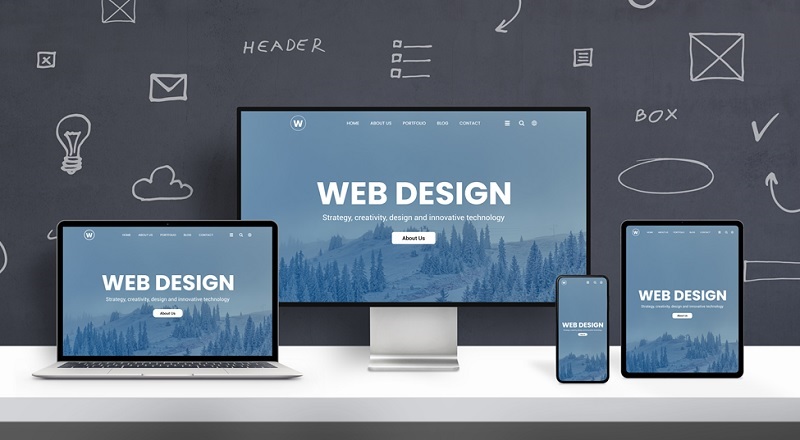How a Website Redesign Increased Conversions by 200%

TechsPlace | As we all know, first impressions matter. Let’s think about your website—it’s essentially the digital face of your brand. A well-devised website redesign can significantly enhance your company’s image, build trust amongst users, and ultimately increase conversions. It’s not just about a visual facelift. It’s about optimizing the structure and functionality to facilitate a smooth user journey, generating a better conversion rate.
Overview of the importance of website redesign and conversion optimization
The decision to overhaul your website is no knee-jerk reaction – it’s a methodical process to improve your visitor’s experience and direct them swiftly and efficiently to convert. Strategic website redesign contributes to:- Improved user experience
– Increased website performance
– Better Quality of leads
– Enhanced website conversions
Brief Explanation of the case study on how a website redesign achieved a 200% increase in conversions
Prepare to dive into an enlightening case study. Today, we’ll zero in on a specific instance where a website redesign transformed a company’s performance by doubling up their conversion rates. Buckle up and get ready to glean some exceptional insights on effective conversion optimization practices.
Background
Let’s start by introducing you to our subject. This success story revolves around ABC Stock Photos, a thriving business that offers high-quality stock photos for sale online. Their previous website design was functional, but lacked the modern, intuitive appeal that today’s users crave. While still supporting sales and customer navigation, there was definitely room for improvement.
Challenges Faced with the Old Website Design
The previous design posed several hurdles. The interface was outdated and not overly user-friendly. Users often complained about the complex navigation system, making it tough to find specific images. Additionally, the site was not optimized for mobile, a critical flaw considering the increasing number of smartphone users.
Goals and Objectives of the Website Redesign
The main aim of the redesign was crystal clear – improve the website’s performance and enhance user experience, ultimately driving more conversions. In order to achieve this, the team outlined the following objectives:1. Create a cleaner, more modern design
2. Simplify navigation
3. Optimize for mobile use
4. Incorporate more user-friendly features like advanced search and categorization
5. Ultimately, increase conversions by 200%
Stay tuned to understand how those objectives transformed into outstanding results.
Strategy and Planning
The journey to a whopping 200% increase in conversions all started with an intricate web of strategy and planning. Let’s delve into the steps undertaken to action this fantastic result.
Overview of the Steps Taken to Plan the Website Redesign
To kick off the website redesign, several processes were put in motion. Foremost was a comprehensive review of the currently existing website to understand both its strengths and areas of improvement. Other actions included thorough market research, setting clear goals and expectations, and creating a detailed timeline of the redesign process. Key tasks involved:- Market Research
– Setting goals
– Building a Timeline
Discussion on the Analysis of User Behavior and Conversion Data
Analyzing user behavior and conversion data was an integral part of the process. The data collected laid bare invaluable insights on how we could optimize the website to better cater to user needs, and consequentially, drive conversions up.
Explanation of the Target Audience and Their Needs
Next up was getting crystal clear on the target audience. Comprehending their needs, preferences, and behaviors, helped us to create a website that ticked all the right boxes for our users.
Description of the Key Strategies Implemented
Lastly, key strategies used in the redesign incorporated SEO optimization, enhancing the site’s loading speed, implementing clear call-to-action buttons and streamlining the navigation. These changes, though seemingly minor, played a major role in making the website more intuitive, user-friendly, and ultimately conversion-friendly.
Design and User Experience Enhancements
Overview of the new website design
Stepping into the exciting world of website redesign, we embraced a clean, intuitive layout focused on appealing aesthetics and enhanced functionality for our new design. Prominent navigation and a sharp, modern look infused the website with a breath of fresh air. We also integrated high-quality stock photos throughout the site to provide a visual feast for visitors, giving a pleasing yet professional finish.
Explanation of the improvements made to enhance user experience
Embarking on an ambitious journey to elevate the user experience, we developed a user-centric model that addressed previous usability pain points. Some highlights included:- Improved site load times for a rapid browsing experience
– Enhanced product filtering and search capabilities
– Streamlined checkout process to reduce shopping cart abandonment
Discussion on the use of persuasive design elements
Design also plays a key role in persuasive techniques to boost conversions. For instance, we utilized strong call to action (CTA) buttons, meticulously placed for optimal visibility. A/B testing was conducted to uncover the most effective strategies, resulting in variations of the CTAs’ color, size, and text to maximize click-through rates.
Description of the responsive design and mobile optimization
In this era, investing in mobile optimization is undeniable. Therefore, the site redesign also meant ensuring a responsive layout adapting seamlessly across different devices. The new mobile-friendly interface, coupled with accelerated mobile pages (AMP), advanced our mobile user experience to new heights, enhancing user engagement and pushing conversion rates to record levels.
Content Optimization
The first step in our journey to a 200% increase in conversions with a website redesign was addressing and optimizing the website content.
Explanation of the Content Audit Conducted
An in-depth content audit was conducted to scrutinize every bit of the existing content. This included assessing the structure, quality, relevance, and SEO value of the text. We identified inconsistencies, outdated facts, grammar errors, and areas lacking engaging content.
Discussion on the Improvements Made to the Website Content
Upon completing the audit, we launched into improving content based on our discoveries. This was twofold:
• Revamping outdated and irrelevant content with updated, user-centric information
• Optimizing underperforming pages with targeted keywords and quality content
Overview of the Use of Compelling Call-to-Action Statements
Another critical step was incorporating strong and compelling call-to-action (CTA) statements. The CTAs were designed to be compelling and urgency-inducing, prompting visitors to take some form of action, thereby improving our conversion rate.
Description of the Implementation of Social Proof Elements
Social proof elements were integrated into the website to solidify trust and credibility. These included customer testimonials, ratings, and reviews, as well as client logos. By displaying these elements, visitors were more convinced about the quality of the services offered, further driving up conversions.
Technical Optimization
Before diving into the details of the redesign, let’s take a look at the nitty-gritty part of this case study — the technical optimization. This process was far from a walk in the park, but the results were worth every painstaking tweak and three o’clock in the morning cup of coffee.
Overview of the Technical Audit Conducted
Initially, a thorough technical audit was carried out to identify existing issues. This was a vital step to ensure the website was in good health before proceeding with the redesign. We analyzed:
– Website architecture
– Mobile responsiveness
– Site speed
– SEO metadata
Explanation of the Improvements Made to Website Performance
Next came the daunting task of optimizing website performance. We implemented a number of fixes such as removing unnecessary plugins, optimizing images, and implementing lazy loading. These steps helped to reduce HTTP requests, resulting in better site speed and improved user experience.
Discussion on the Optimization of Page Load Speed
Page load speed is a critical factor for both SEO and user experience. We ensured the website was lightning fast by:
– Compressing files
– Minifying CSS, JavaScript, and HTML
– Improving server response time
Description of the Implementation of Structured Data Markup and SEO Best Practices
Finally, we employed structured data markup for better SERP output. This included adding schema markup for reviews, products, and local business. In addition to this, we also followed SEO best practices like using SEO-friendly URLs, implementing meta tags, and ensuring keyword usage in content.Stay tuned to find out how these technical optimizations played a key role in revolutionizing conversions for the website.
Testing and Iteration
Website redesigning is a rigorous process that can’t be undertaken haphazardly. In order to gauge the effectiveness of the newly introduced elements, various testing methods, particularly A/B testing, were applied.
Discussion on the A/B Testing conducted
Why A/B testing, you may ask? A/B testing involves creating two versions of a webpage – A and B. Version A is typically the current design, while version B features the changes you want to test. Visitors are then randomly directed to either version and their interaction with the website is tracked and analyzed. In our case study, we put into action numerous A/B tests to pinpoint exactly which changes were doing the trick in boosting conversions.
Overview of the Data Analysis and Insights Gained
Then came the step of keenly analyzing the data drawn from these tests. Performing a granular analysis, specific changes were identified which drastically enhanced user interaction, eventually driving up the conversion rate. Some key improvements that emerged included simplified navigation, more compelling calls-to-action, and improved loading speed.
Description of the Iterative Approach and Continuous Improvement Process
The one-off approach simply doesn’t cut it in today’s fast-paced digital world. As a result, we adopted an iterative approach for the redesign, which entailed making continuous, often small, improvements to the website based on data and feedback rather than having a one-time overhaul. This culture of continuous improvement and repeated testing ensured that the performance of the redesign was closely tracked and progressively refined until an impressive 200% increase in conversions was achieved. This clearly shows the power of a systematic, data-led approach to website redesigning.
Results and Analysis
One of the most crucial aspects of a website’s redesign is justifying the effort by quantifying the improvement. Let’s look into the specifics.
Explanation of the Measurement and Tracking of Conversions
Crafting an effective website requires a solid grasp of the desired conversions and how to track them. In this particular case, ‘conversions’ referred to visitors who completed a desired action— specifically, purchasing stock photos. Advanced technical tools like Google Analytics were used to comprehensively track this data. Methods included tracking:- Total completed transactions
– Rate of cart abandonment
– Visitor’s journey from landing to checkout
Discussion on the Achieved 200% Increase in Conversions
After the redesign, conversions soared by an incredible 200%. This change was backed by a series of optimization strategies including improved site navigation, condensed checkout processes, and a smoother mobile experience. It was clear that addressing these user experience pain points directly boosted the conversion rate.
Overview of the Impact on Website Traffic and Engagement Metrics
A key secondary benefit of this website redesign was a significant surge in website traffic and improved overall engagement. Metrics like time spent on the site, click-through rates, and pages visited per session saw considerable uplift.
Description of the ROI and Business Growth Achieved
Finally, the revenue impact of this surge in conversions was substantial. The return on investment (ROI) for the site redesign was off the charts, easily justifying the resources spent. Coupled with the increased website traffic, these positive changes propelled significant business growth. In sum, this case study illustrates the extraordinary potential of a well-executed website redesign.
Key Takeaways and Lessons Learned
In this section, we will condense the main strategies, tactics, and lessons learned from this powerful case study.
Summary of the key strategies and tactics that led to the successful website redesign
Our 200% increase in conversions was driven by three key strategies. Firstly, we conducted extensive A/B Testing to determine the highest performing design elements. Secondly, an intensive focus on User Experience (UX) allowed for a smoother browsing experience, which helped retain users on the site. Lastly, we implemented a strong SEO strategy to amplify our reach and visibility.- A/B testing to identify effective design elements
– Prioritized user experience for smooth browsing
– Strategic utilization of SEO to enhance reach
Discussion on the lessons learned from the case study
From this website redesign, we learned that understanding user behavior is central to achieving high conversion rates. A tidy, intuitive interface coupled with strong site performance sweats the small stuff, so the users don’t have to.
Overview of the key takeaways applicable to other websites and businesses
This experience holds valuable lessons for all websites and businesses looking to convert site visits into actions. These include the benefits of an intensive focus on user experience, the power of detailed testing, and the need for effective SEO practices to increase site visibility. The overall takeaway? A well-designed, user-friendly site that ranks well on search engines is a sure-fire recipe for conversion success.
Conclusion
Recap of the case study on how a website redesign increased conversions by 200%
We’ve taken a deep dive into how a meticulous website redesign resulted in a whopping 200% increase in conversions. We explored key strategies such as improving website performance, implementing conversion optimization techniques, and using high-quality stock photos to enhance the website’s visual appeal. The case study reiterates:- The significance of speed and seamless navigation in improving user experience.
– The role of visually engaging design elements in drawing and holding audience attention.
– The power of conversion optimization techniques in translating traffic into conversions.
Final thoughts on the importance of website optimization and continuous improvement in driving conversions.
In conclusion, website redesign isn’t just about aesthetics; it’s a strategic undertaking with a significant impact on conversions. It’s about marrying form and function, making continuous improvements, and ensuring your site is an effective conversion tool. This case study underscores the fact that with the right strategies in place, a mindful website redesign can substantially boost conversion rates. So, keep testing, keep refining, and remember – your website is never truly ‘finished’, it’s an evolving digital storefront that can always be optimized to increase conversions.
Image via: Dreamstime.com
This article is contributed by guest author on techsplace.com.





